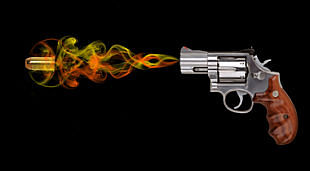UAlbany Chemists Develop “Fingerprint” for Identifying Crime Scene Ammunition, Targets Wider Range of Trace Evidence than Current Methodologies
Approach Tackles Newer Bullets, Eliminates the Need for Expensive Analysis Equipment
ALBANY, N.Y. (March 28, 2014) -- University at Albany researchers Igor K. Lednev and Justin Bueno have developed a rapid and accurate method that allows crime scene investigators to recover and detect GSR from a crime scene or shooting suspect. The novel approach combining tape lifting and attenuated total reflectance (ATR) Fourier transform infrared (FT-IR) spectroscopic imaging complements their previous research in determining the kind of ammunition shot from a gun based on gunshot residue (GSR) left behind. The new approach could have applications in the fields of homeland security and counter-terrorism.When a gun is fired, particles from the bullet are discharged onto the shooter’s hands and clothes, nearby furniture, and other surfaces. The presence or absence of this residue can determine whether a gun was discharged and — based on its location on clothing and other surfaces — who and what was near the weapon when it was fired.
 |
|
University at Albany researchers have developed a rapid and accurate method that allows crime scene investigators to recover and detect GSR from a crime scene.
|
Lednev and Bueno investigated a novel approach for detection of GSR using ATR-FT-IR spectroscopic imaging. The chemists’ method creates a “fingerprint” which targets a wider range of chemicals than existing methodologies. Current processes recreate a crime scene story only in hazy detail. The most widely used technique today specializes in detecting the heavy metals that some ammunition contains. Newer bullets, however, aren't necessarily made with heavy metals, making analyses much more difficult. Also, existing methods require expensive equipment and a lot of time -- luxuries law enforcement can’t afford.
Their work is detailed in a study published this month in the American Chemical Society journal Analytical Chemistry. The researchers contend that ATR-FT-IR analysis of GSR is nondestructive and offers a useful molecular “fingerprint” of the detected GSR. Vibrational (infrared and Raman) spectroscopy of organic residue offers a considerably more unique spectrum and thus higher specificity, when compared to the analysis of GSR with elemental spectroscopy.
Organic gunshot residue (OGSR) comprises explosive materials originating from the propellant of the discharged ammunition, while inorganic gunshot residue (IGSR) is formed from the inorganic contributions of the ammunition primer, propellant, projectile (bullet), and cartridge case. Detection of GSR at a crime scene is critical, as it is indicative of a shooting incident. Furthermore, detection of GSR on the body or clothing of a person indicates their presence and often degree of involvement in a crime.
Lednev, an international expert in laser spectroscopy and a member of the White House Subcommittee on Forensic Science, is renowned for the development of an easy-to-use approach for crime scene investigators (CSIs) to identify body fluid traces at crime scenes. Utilizing Raman spectroscopy, Lednev's approach allows investigators to quickly make on-field, confirmatory identifications of body fluids. The portable spectrometers -- devices used to measure properties of light over a specific portion of the electromagnetic spectrum -- are capable of differentiating between human and animal species, and in determining the age of a biological stain.
![]() For more news, subscribe to UAlbany's RSS headline feeds
For more news, subscribe to UAlbany's RSS headline feeds
A comprehensive public research university, the University at Albany-SUNY offers more than 120 undergraduate majors and minors and 125 master's, doctoral and graduate certificate programs. UAlbany is a leader among all New York State colleges and universities in such diverse fields as atmospheric and environmental sciences, business, education, public health,health sciences, criminal justice, emergency preparedness, engineering and applied sciences, informatics, public administration, social welfare and sociology, taught by an extensive roster of faculty experts. It also offers expanded academic and research opportunities for students through an affiliation with Albany Law School. With a curriculum enhanced by 600 study-abroad opportunities, UAlbany launches great careers.


